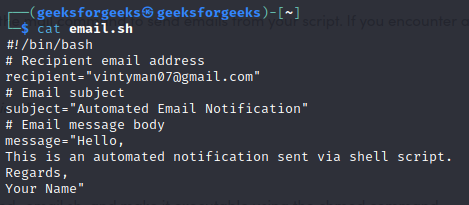
|
|
In today’s fast-paced digital world, email remains one of the most essential communication tools. Whether it’s for business correspondence, personal communication, or automated notifications, sending emails efficiently is crucial. Shell scripting offers a powerful way to automate various tasks, including sending emails. In this comprehensive guide, we’ll delve into the world of shell scripting for email automation, exploring how to craft a shell script to send emails effortlessly. Understanding Shell Scripting and Email AutomationShell scripting involves writing sequences of commands that are interpreted and executed by a shell interpreter. It provides a convenient way to automate repetitive tasks and streamline workflows in a Unix-like environment. With the help of shell scripting, you can perform a wide range of tasks, from file manipulation to system administration. Email automation using shell scripts enables users to send emails programmatically without manual intervention. This capability is particularly valuable for tasks such as sending notifications, alerts, reports, or batch processing results. By leveraging shell scripting for email automation, you can save time, minimize errors, and ensure consistent communication. PrerequisitesBefore diving into shell scripting for sending emails, ensure that you have the necessary tools installed on your system. You’ll typically need:
Crafting a Shell Script to Send EmailsNow let’s explore the process of creating a shell script to send emails. We’ll break down the steps involved and provide a sample script for reference. Step 1: Define Script ParametersBegin by defining the necessary parameters for your script, such as the recipient email address, subject, and message body. You can either hardcode these values directly into the script or pass them as command-line arguments.
 displaying text inside script Step 2: Construct the Email CommandNext, construct the command to send the email using your MTA’s command-line interface. The exact command may vary depending on your MTA. Below is an example using the mail command, which is commonly available on Unix-like systems. Before constructing the email command we have to install mail. In Kali Linux, you can install the mailutils package to send emails via a script using the mail command. Here’s how you can install it: sudo apt update  installing mailutils for mailing Once mailutils is installed, you should be able to use the mail command to send emails from your script. If you encounter any issues or need further assistance, feel free to ask!
construct email Step 3: Save and Execute the ScriptSave your script with a meaningful name, such as send_email.sh, and make it executable using the chmod command. chmod +x email.sh
You can then execute the script from the command line to send the email. ./email.sh
 save and execute the script Enhancements and ConsiderationsWhile the above script provides a basic framework for sending emails via shell scripting, there are several enhancements and considerations to keep in mind:
ConclusionShell scripting provides a powerful means of automating various tasks, including sending emails. By crafting a shell script to send emails, you can streamline communication processes, save time, and improve efficiency. With the knowledge gained from this guide, you’re equipped to leverage shell scripting for email automation in your workflow. Happy scripting |
Reffered: https://www.geeksforgeeks.org
| Linux Unix |
| Related |
|---|
| |
| |
| |
| |
| |
Type: | Geek |
Category: | Coding |
Sub Category: | Tutorial |
Uploaded by: | Admin |
Views: | 16 |